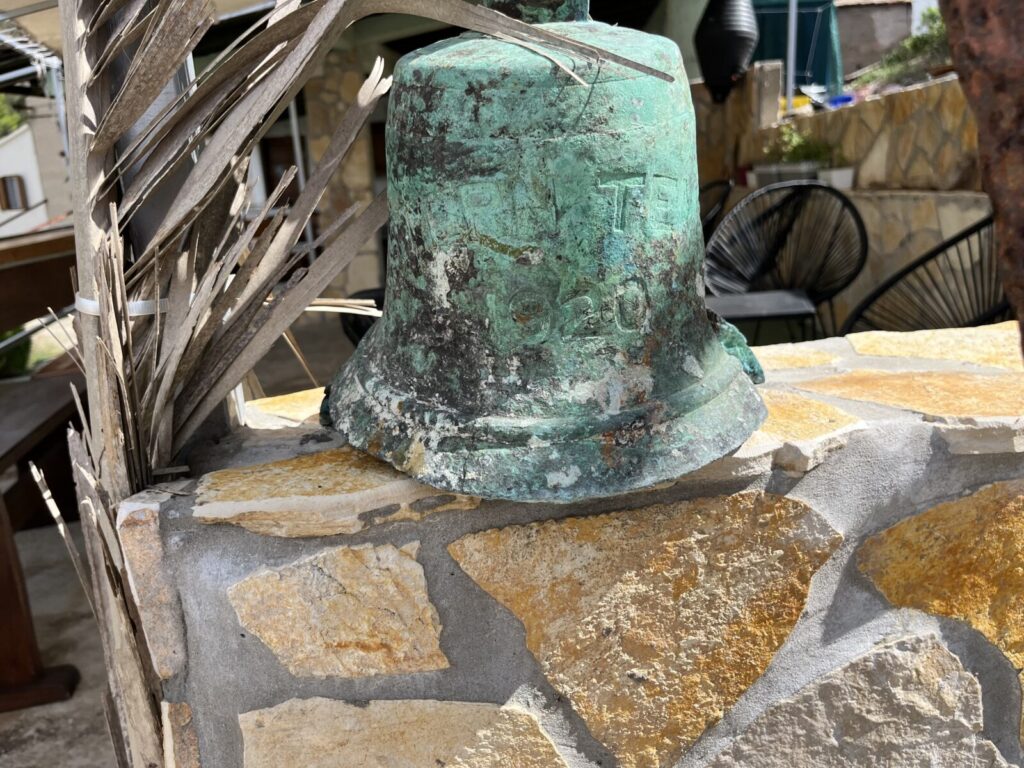Vassilios T

Vasilios T would start her life in Osaka, Japan as Yard Number 10, she would eventually be named Eastern Temple and become part of the war requirements of the USA, following their entry into World War 1, 02nd April of 1917. For those of you who love the technical detail:

When The USA finally joined the First World War in 1917 it was after a series of meetings between the First Sea-Lord of the British Admiralty, Winston Churchill, and the US President Woodrow Wilson, Wilson did not want to commit US troops to the war in Europe however Churchill was desperate that he did….. Some say it was no co-incidence that two years earlier, in 1915, the Luxury Liner Lusitania continued to cross the Atlantic carrying American citizens aboard despite the war, and despite the Germans declaring unrestricted warfare on the high seas

Lusitania’s owners, the Cunard Line were British and trade was brisk, Lusitania was one of the fastest ships afloat, between 1907 & 1909 she had won the Blue Riband for the fastest crossing between Queenstown, Ireland and Sandy Hook in New York, no less than 4 times, a crossing of 2780 Nautical Miles, completed in 4 days Sixteen hours and 40 minutes, almost a full 12 hours better than the previous holder, the German Liner Deutschland. There was something to be said for Cunard’s assertion that Lusitania, capable of 25 Knots (47 MPH), could outrun any U-Boat, but the Lusitania didn’t have to outrun any German U Boat……She had to outrun their torpedo’s
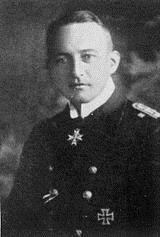
It only took one of those torpedo’s, from the German Type 19 U-Boat, U20 on the 07th May of 1915, to send the Lusitania, to the bottom of the Atlantic off Old Kinsale Head in Southern Ireland, just a couple of hours out of Liverpool and safety. Lusitania had been carrying 1266 passengers with a high contingent of US citizens aboard it, 123 of whom perished in the attack, Germany issued a statement in which they claimed that because Lusitania “carried contraband of war” and that she “was classed as an auxiliary cruiser,” which, in the eyes of the German’s meant U20 had a right to destroy her regardless of any passengers aboard

Germany also pointed to warnings printed in the US papers, alongside all advertising by Cunard and the major passenger liner companies, stating any passengers sailing on British ships did so at their own risk, it didn’t stop international outrage at the sinking of the Lusitania, but it is doubtful Kapitanleutnant Walter Schweiger or the crew of U20, suspected they had sewn the seeds that would bring the US into the war on the side of Britain and her allies almost two years later
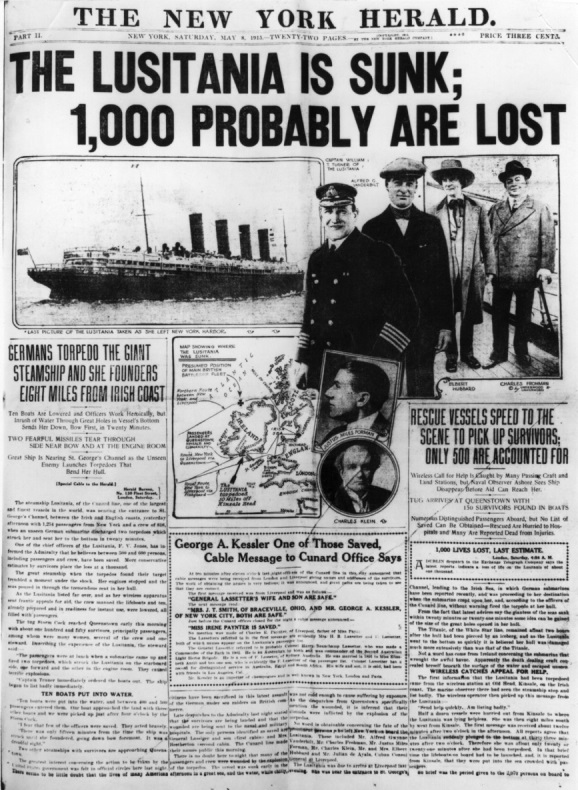
Why did Woodrow Wilson wait two years to enter the war, with 123 US citizens at the bottom of the Atlantic you could be forgiven for thinking an act of war against the US had been carried out, and immediate response was necessary, as I am sure Winston Churchill believed, but Wilson was determined to stay neutral and act as nothing more than peacemaker between Britain & Germany, Germany apologized for the loss of American lives on the Lusitania and pledged to end unrestricted submarine warfare in the Atlantic from that point
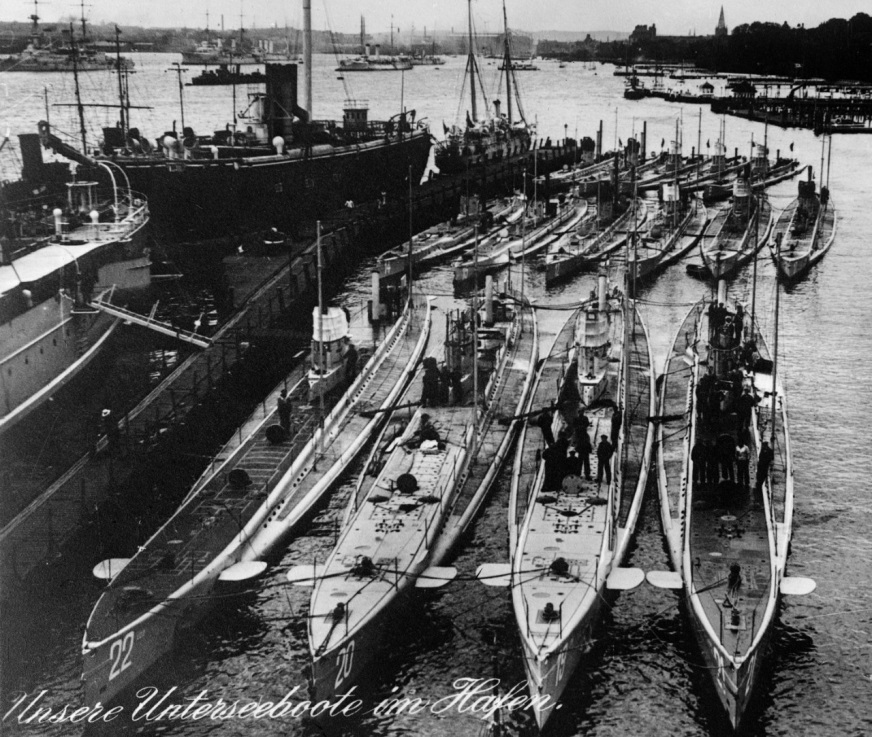
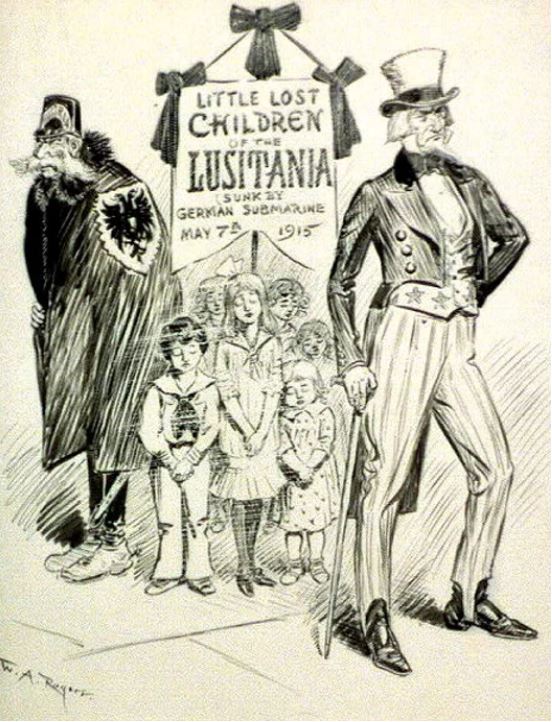
In 1917 Germany, suffering from the effects of British sea blockades around their very small coastal region, and, with a population on the verge of starvation, declared a return to unrestricted submarine warfare and worse, the Germans were caught red-handed (Zimmerman Telegram) offering Mexico support for any action towards the return of Texas, Arizona and New Mexico (if they supported Germany against Britain and her allies) should the US join the war on the side of Britain…….
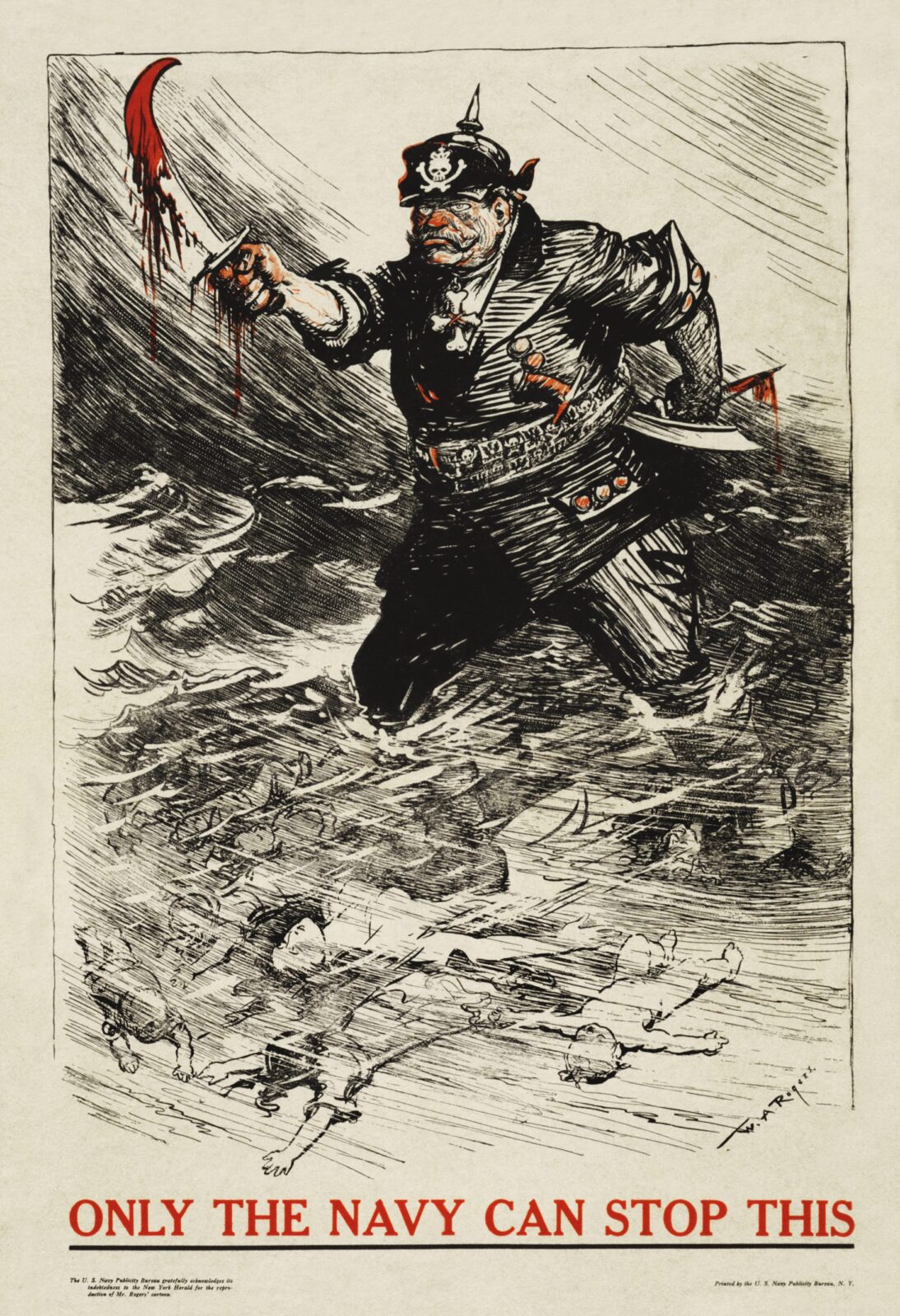
Enough was enough it seemed and despite the obvious reluctance to join the “European” conflict that had coloured US public opinion for the intervening years, in April of 1917 Woodrow Wilson went to the US Congress and asked for a formal declaration of war against Germany & her allies. The request went to Congress and the House of Representatives but, after both agreed, on the 07th of December 1917 The United States finally declared war on German and her ally Austria-Hungary

So what has U20, the sinking of the Lusitania, and the USA’s entry into World War I got to do with the Vasilios T, or as she was known in 1918, The Eastern Temple? To understand this we need to go back a little, before the sinking of Lusitania, indeed to 1914, at the outbreak of World War I, when it seemed the USA had little ambition for international ocean trading (Day, Edmund E. “The American Merchant Fleet: A War Achievement, a Peace Problem” in The Quarterly Journal of Economics, Vol 34, No 4, pp1-41. Aug 1920. Oxford University Press. Online Resource: https://www.jstor.org/stable/pdf/1885158.pdf Accessed 26/01/2022) “In 1910 the American fleet had fallen to one-twentieth the size of the British; and less than one-tenth of American seaborne foreign trade moved under United States flag. For years before the war, attempts to foster merchant shipping met with stolid indifference when not with vigorous opposition. The business men of the country were convinced that ocean transportation was an industry in which American labor and capital could not profitably engage” As the conflict in Europe became more and more likely to drag the US unwillingly, and ill-prepared into war, the Americans, perhaps realizing their merchant fleet was unlikely to serve their needs in regards to increasing trade between the US and the needs of those in Europe (on both sides, for supplies and materials to immediately sustain their populations, and to enable them to continue fighting) opened their merchant shipping registry (Day, Edmund E. “The American Merchant Fleet: A War Achievement, a Peace Problem” in The Quarterly Journal of Economics, Vol 34, No 4, P570. Aug 1920. Oxford University Press. Online Resource: https://www.jstor.org/stable/pdf/1885158.pdf Accessed 26/01/2022) Edmund Day has it that the Panama Canal Act of August 24 1912, supplemented by an act of August 19, 1914, removing a five year age limit on vessels applying for registry, accepted that: “Foreign-built vessels thereafter could obtain American registry upon passing the Steamboat Inspection Service test for seaworthiness. Numerous owners of foreign-built vessels quickly took advantage of the free registry act. The greater safety under neutral flag was apparently more than an offset to more expensive American operation.” Meanwhile cries were going up in the US press for more home built ships…..

Although the US Government took up the cries for merchant shipping production, with ship-yards such as Philadelphia’s Hog Island turning to mass-production techniques and making a significant difference to the speed of construction, the US simply could not keep up with demand for shipping to replace losses, and cope with the increased trade demands of the Allies necessary for the war effort: Charles Geisst, writing in the Encyclopedia of American Business History, “….The domestic yards were swamped with orders and had a backlog of many years. Another shipbuilding boom, reminiscent of that during the civil war, had begun, but builders could not produce ships fast enough to end the crisis” (Geisst, C.R. & Gargano, C. “Encyclopedia of American Business History. P386. Shipbuilding industry, Para2.” Online Resource: https://books.google.co.uk/books?id=5dGig0fYlj8C&pg=PA386&lpg=PA386&dq=US+cries+for+shipbuilding+1917&source=bl&ots=2vqI-8zYhB&sig=ACfU3U2MYROQVyH0dS2XtDAT7CgGbhmRXA&hl=en&sa=X&ved=2ahUKEwjLsd_239H1AhVPf MAKHZrABxoQ6AF6BAg7EAM#v=onepage&q&f=false Accessed 27/01/2022) There would have to be another way to ensure the need for merchant shipping was met by the supply of merchant ships
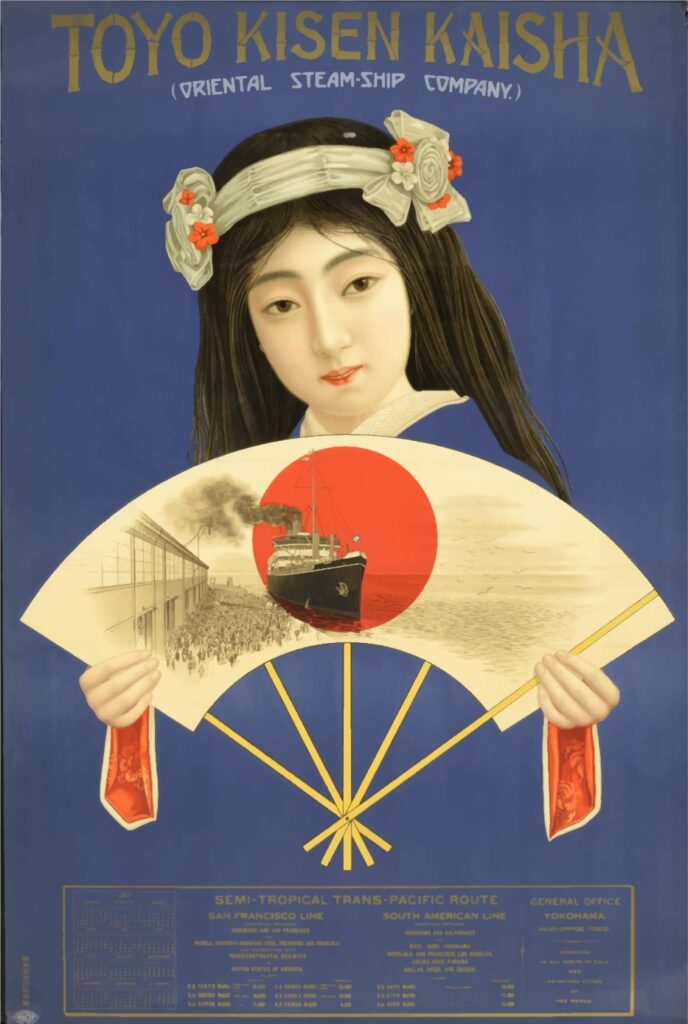
When WWI broke out in 1914 the Japanese had not long ended their war with Russia (the Russo Japanese war of 1904-1905), Russia was an ally to Great Britain against the Austro-Hungarian & German Empire in what was, at that time, mostly a European war as far as the US was concerned. Japan was also an ally of Britain, despite serious misgivings at their motives by the British Foreign Secretary, Sir Edward Grey, however his caution was not shared quite so explicitly by Winston Churchill, obviously losing patience with Grey in a terse telegram of August 1914: (Saxon, Timothy, D. “Anglo-Japanese Naval Cooperation, 1914-1918 In: Naval War College Review. Vol 53, No 1, P66, Para 2” Online Resource https://www.jstor.org/stable/44643068?seq=16#metadata _info_tab_contents Accessed 27/01/2022) “I think you are chilling indeed to these people. I can’t see any half way house between having them in and keeping them out. If they are to come in, they may as well be welcomed as comrades. This last telegram [to Japan] is almost hostile.” Churchill rounded off with “You may easily give mortal offence_which will not be forgotten_we are not safe yet_by a long chalk. The storm has yet to burst”
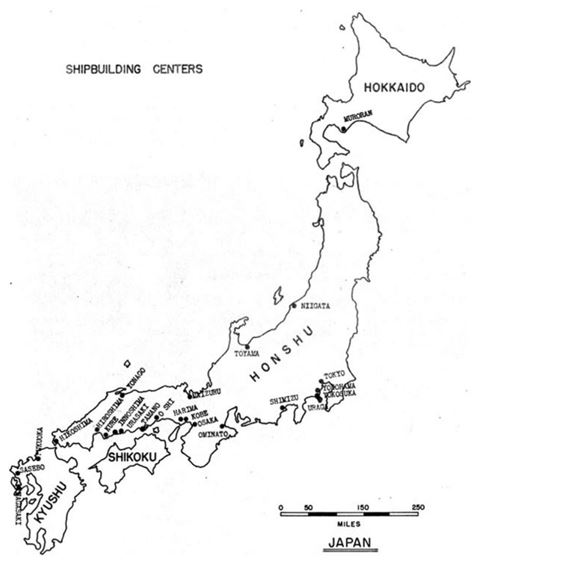
Despite Grey’s obvious concerns, Japan was both an ally and a ready and willing supply source of available merchant shipping, desperately needed for the war effort, there was little choice and an easy decision to be made: “In 1917, Japanese shipyards hastily constructed (in five months) twelve destroyers identical to the Japanese Kaba class for France: Japanese sailors delivered the ships to French forces in the Mediterranean. In December of 1916, the British chancellor of the exchequer sought and gained the War Cabinet’s approval for the purchase of six Japanese merchant ships, totaling 77,500 tons, The British further requested in May 1917 that the Japanese supply shipping for Chinese workers recruited to work in Europe: Japanese warships helped to escort the convoys to France. Later in the war, Japan and the United States agreed that Japanese shipyards would produce 371,000 tons of shipping for the U.S. Shipping Board.”
(Saxon, Timothy, D. “Anglo-Japanese Naval Cooperation, 1914-1918 In: Naval War College Review. Vol 53, No 1, P77, Para 1” Online Resource https://www.jstor.org/stable/44643068?seq=16#metadata_info_tab_contents Accessed 27/01/2022)
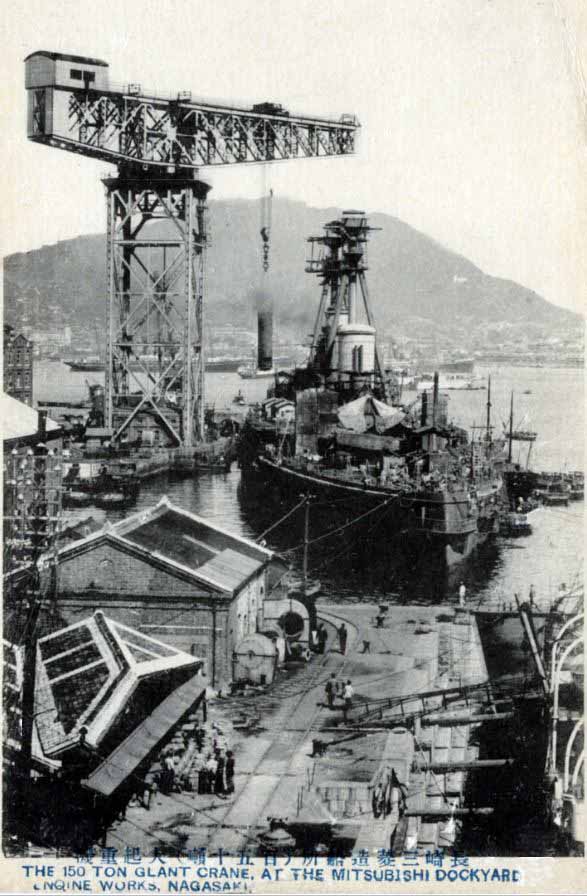
The Japanese had capacity to help the allies and were willing to turn their impressive and modern shipyards to the war effort too, “Across the harbour from Nagasaki are the Akuno-ura Engine Works, and the Mitsubishi Dockyards, the latter one of the largest of its kind in Nippon [Japan]. It was established in 1856 by the Tokugawa shogunate, under the tutelage of Dutch engineers, but was transferred to the Mitsubishi Co. in 1877; since then its growth has been rapid. Battleships and ocean going steamers of large tonnage are built here (ships like the Tenyo Maru and the Chiyo Maru of the Toyo Kisen Kaisha) and upward of 5000 men are employed. There are 3 dry-docks, salvage steamers, etc” (Terry, Philip. “Terry’s Japanese Empire” Houghton & Mifflin Co, Boston & New York, 1914. In “Old Tokyo Mitsubishi Shipyard, Nagasaki, c1910”. Online Resource: http://www.oldtokyo.com/mitsubishi-shipyard-nagasaki-c-1910/ Accessed 27/01/2020)
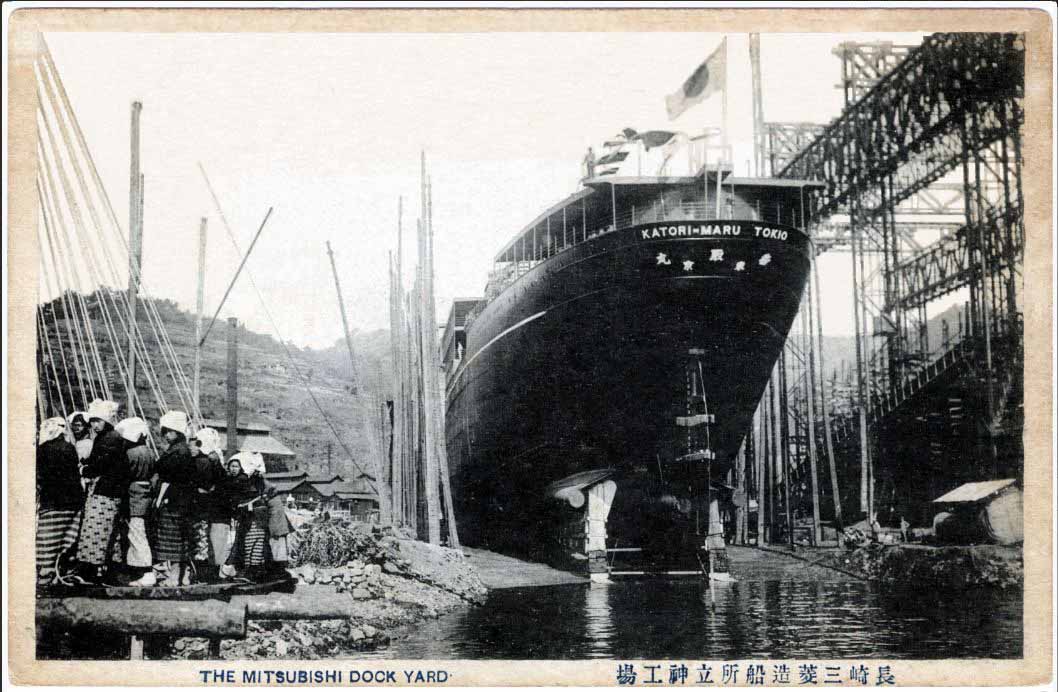
So, it was to Japan that the US Shipping Board turned to in 1916 following the introduction of the Shipping Act of September 07th 2016: “The Shipping Act was a compromise between those favoring a comprehensive program of government ownership of merchant shipping and those advocating continued reliance upon private initiative. Under the provisions of the act, the United States Shipping Board was empowered to build, repair or alter, buy, lease, or charter merchant vessels.” (Day, Edmund, E. “The American Merchant Fleet: A War Achievement, a Peace Problem” in “The Quarterly Journal of Economics Aug 1920 Vol 34 No 4 P 571.” Oxford University Press. Online Resource: https://www.jstor.org/stable/pdf/1885158.pdf Accessed 28/01/2022). The year following brought an even more significant act of congress when the US introduced the Urgent Deficiencies Appropriation Act of June 15 1917 authorizing Woodrow Wilson, amongst other things, to: “To place an order with any person for such ships or material as the necessities of the Government, to be determined by the President, might require during the period of the war;” Congress authorized $250,000,000 for the spend and Wilson signed an executive order delegating his powers under the act to the Emergency Fleet Corporation and the Shipping Board
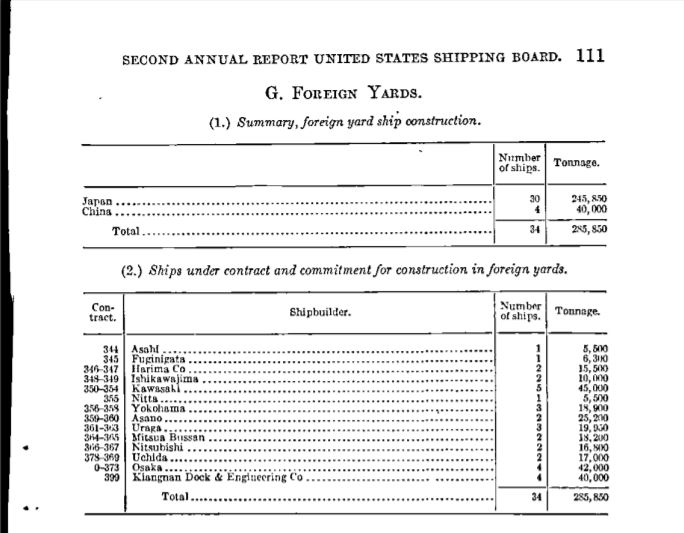
As it was clear there were insufficient ships available from the US yards to meet the requirements of war, even with the transfer of part constructed merchant shipping to the war effort, it was necessary to buy from foreign sources, and Japan could help……..Edmund Day (P586) notes “From the Japan- ese, however, it was possible to purchase thirteen steel cargo vessels already constructed and to contract for the building of thirty others.” The Thirteen Japanese ships already complete were given a classification “Eastern” of which the Eastern Temple would become the Vasilios T
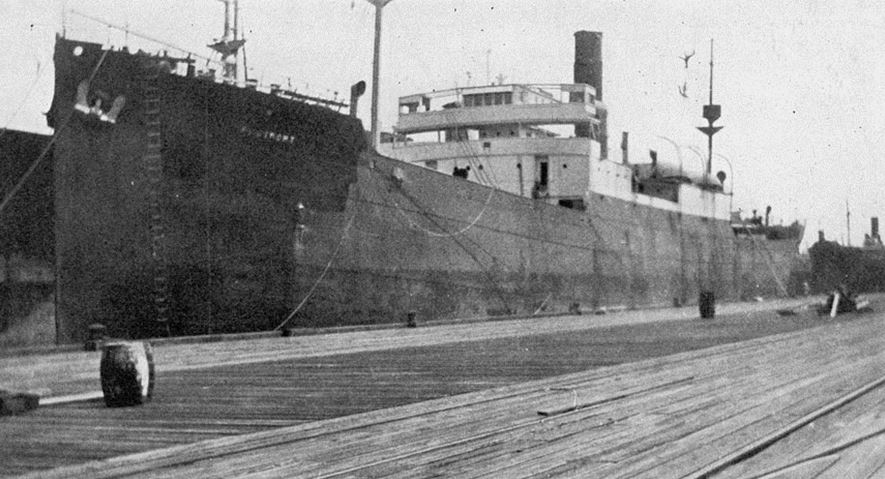
Of the Japanese ships from the 1917 contract, there were only the thirteen which had been available from the outset (none of those who’s keels were on the slip, or that were ordered to be built were delivered in time to see service), but of the thirteen that were contracted, only three from the Osaka Iron Works seem to have been delivered in time to take part in the war, the Eastport (Yard No 907), the Eastern Star (Yard No 915) and the Eastern Light (Yard No 951), (McKellar, N.L. The Belgian Shiplover No96, 09/1963, P503. Osaka Iron Works: in “Steel Shipbuilding Under the U.S. Shipping Board, 1917-1921” Online Resource: https://www.shipscribe.com/mckellar/Contract6.pdf Accessed: 29/01/2022) so we know that Vasilios T (Eastern Temple) did not see service in WWI. Information on these ships is elusive; the few sources available hold little information, perhaps due to the tenuous nature of the initial contractual arrangement with the US, perhaps due to the scarcity of remaining WWI records
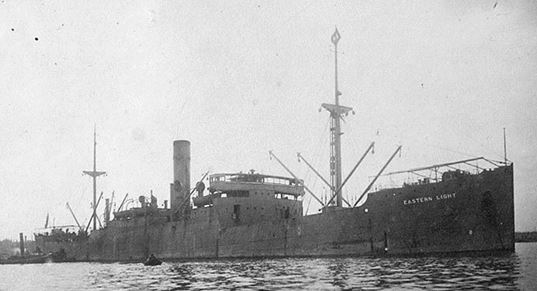
The Eastern Temple eventually arrived in the US to no small fanfare, following her departure from Osaka on the 18th of June of 1920, it seems three vessels were departing for the USA at the same time, each with a Japanese crew and each with a captain determined to make the crossing and arrive on US soil before either of the others, so much so there was a wager between them (Editorial: Morning Oregonian June 24 1920 P20 Online Resource https://oregonnews.uoregon.edu/lccn/sn83025138/1920-06-24/ed-1/seq-20/ocr/ Accessed 09/02/2022)
“With a prize of $3000 at stake, three Japanese-built freighters for the account of the United States shipping board are racing across the Pacific from Yokohama with San Francisco as their goal. The vessels are the Eastern Leader, Eastern Soldier and the Eastern Temple, and all three left Yokohama within 48 hours of each other. According to reports dispute arose between the skippers of the respective crafts as to their steaming capabilities. It was finally decided that each of the captains put up 91000 In American gold, the vessel making the best elapsed time between the two ports to receive the wager. The vessels sailed from the oriental port June 18”
I have nothing but admiration for the 3 captains who’s names have disappeared into history so far, the vessels were pretty much identical, I suppose the speed of crossing was down to the routes the captains took and their navigational skill, rather than any particular advantage from the vessels themselves, sadly history does not record who actually won the wager
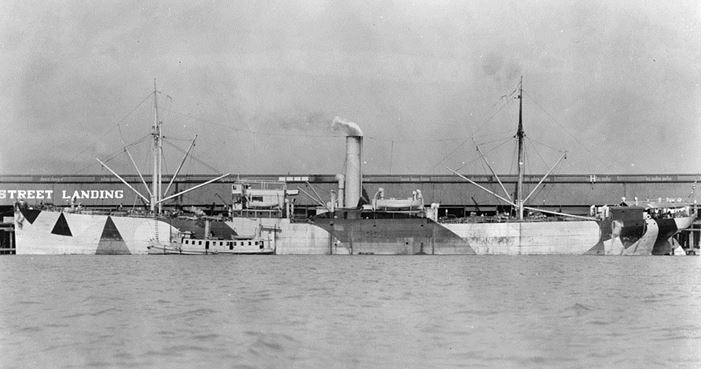
The Eastern Temple’s arrival was announced in the 03rd August edition of the Morning Oregonian, without fanfare, it could be assumed therefore that she had perhaps not won her captain the wager: “The 5500-ton steamship Eastern Temple, which arrived here last week, will be delivered to the fleet corporation Thursday or Friday. She is a product of the Osaki yard of the Nitta Kisen Kabushiki Kaisha, but will be delivered by the Suzuiki company, which brought her across the Pacific”
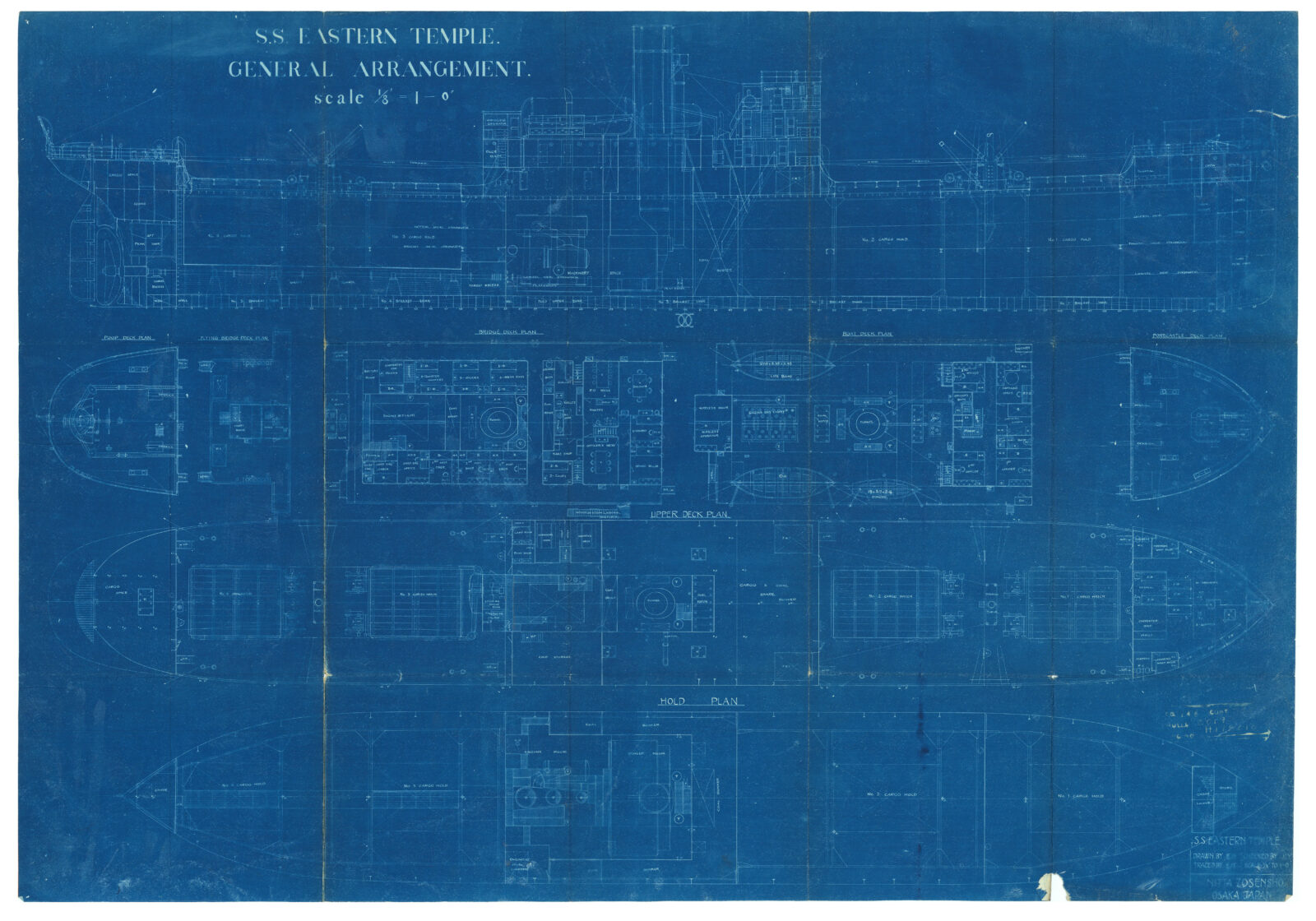
It did not take long to put Eastern Temple to work and again the Morning Oregonian (14th September 1920) has her: “To load lumber for Peru & Chile the Eastern Temple is loading at the Danaher mill. She is taking 60,000 feet there. She will also take 100,000 feet at the St. Paul mill export dock” The mills identified would be Washington Lumber Mills, Danaher’s was a significant operation beginning in 1893 “Danaher had purchased a mill from Abraham Coon Young after the panic of 1893. Danaher eventually acquired mills in California, large tracts of timber throughout the Northwest, and logging camps at Darrington and Port Orchard, Washington. During 1918 and 1919 his mill turned out forty million feet of cut lumber making it the fourth largest mill in Tacoma” (Holcomb, J. “Lumbermen and the Four Ls: It’s Time for All Lumbermen to Spruce Up!“: Pacific University, May 1999 Online Resource: https:// commons.wikimedia.org/ wiki/File: Logging_crew_and_donkey_engine,_Danaher_Lumber_Company,_ca_1916_(KINSEY_139).jpeg Accessed 09/02/2022)
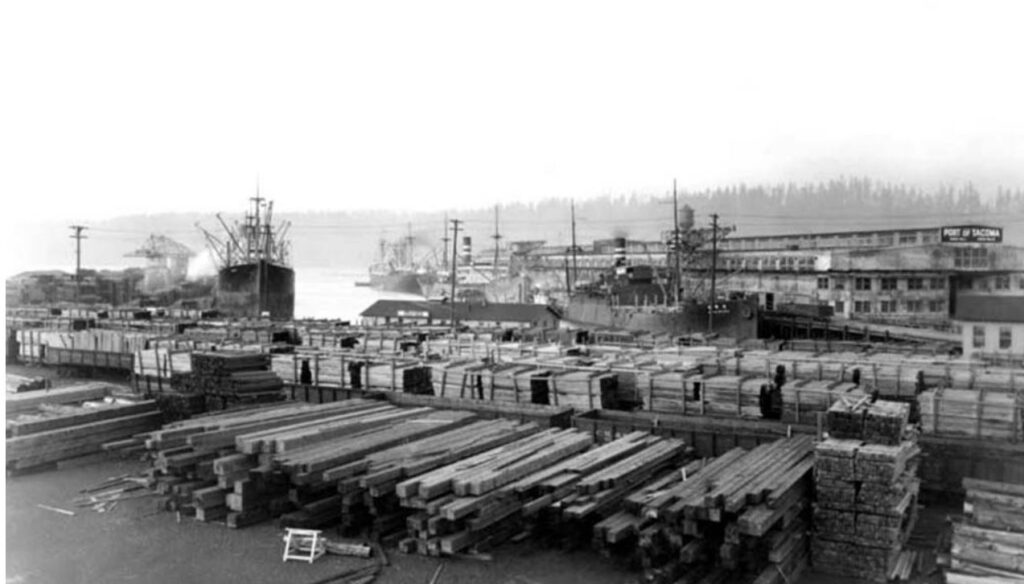
Lumber was a huge export from the US in the early 1900’s, by 1924 Grays Harbour celebrated loading its billionth foot of board, and the seemingly inexhaustible forests and associated logging trade had named it “King Timber”: (Caldbick, J. “Deep-draft Ports of Washington: King Timber and the Growth of Ports” HistoryLink.org Online Resource https://www.historylink.org/File/9529 Accessed: 09/02/2022) “In the early decades of the twentieth century the forest resource in Washington still seemed infinite, and the magnitude of the harvest each year was staggering. Billions of board feet of lumber and countless tons of raw logs were shipped through the state’s deep-draft ports, and they all cut their teeth on the timber trade.” It couldn’t last, but the US was certainly making hay whilst the Sun shone, and the Eastern Temple would play her part in that

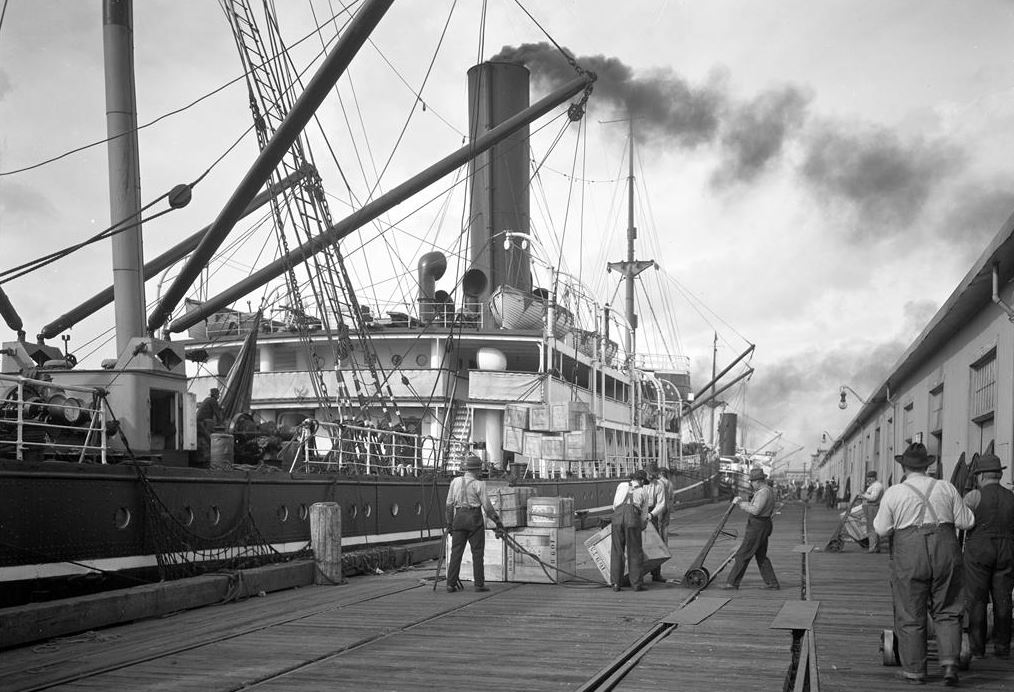
The Eastern Temple was set to the South American trade by her managers, the General Steamship Corporation, her first trip would be carrying the Washington Lumber from Tacoma to Peru & Chile. It seems she narrowly missed a devastating explosion when, on the 10th September 1920 two barges, both carrying Dynamite, collided in the port of Callao (Peru’s main Port & Docks) and exploded. The blast killed fifty people in the port and surrounds and was reported in the Chicago Daily Tribune (11th September 1920 P1). Wherever she was headed the Eastern Temple seems to be at the heart of some type of drama from the start of her career……
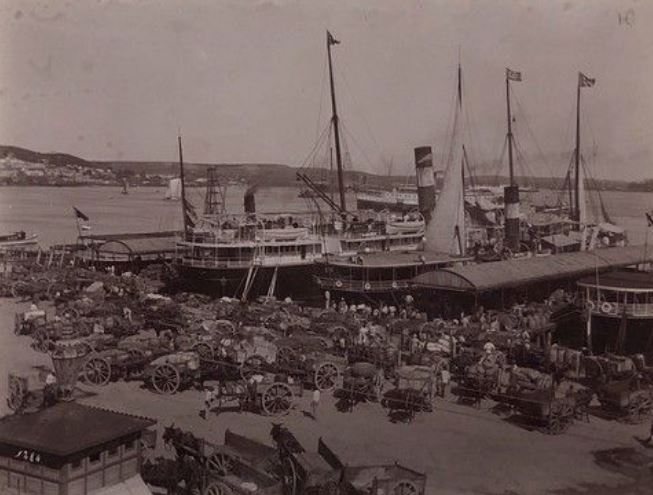
Even though Eastern Temple had left the US and was now in the South Americas controversy was not far behind her. The arrangement that the US Shipping Board had bought her under was explicit, the ship would be delivered to the US by the selling yard, Osaka, that’s fine, the crew would therefore be Japanese and likely the Captain (although not compelled to be), a US citizen. It clearly had not been lost on the Japanese crew that the US offered a potentially better life than that they enjoyed in Japan, the Oregon Daily Journal of 03rd August of 1920 (P3): “…..eight Japanese members of the crew of the Japanese liner Eastern Temple were in custody here today charged with attempting to smuggle themselves into this country”. The crew of the Eastern Temple, or at least the eight in custody clearly believed the US was a better prospect than a return to their native Japan. If nothing else, this shows the times were fast turning in favour of the US, immigration into America was on the increase, and it wasn’t just Europeans that believed it to be the land of opportunity. The US immigration officials clearly believed this was a common occurrence, the Oregon Journal goes on to note: “This means of entry, according to immigration officials, is common. Japanese, for a suitable consideration, are said to be signed as part of the ships “crew”, this being merely a ruse.”
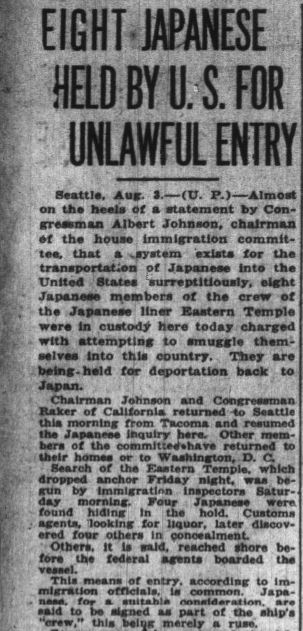
Whilst the USA dealt with the problem of absconding crew from the Eastern Temple and other fleet ships bought from Japan in the closing year or so of World War One, other countries were challenged by the conflict, in ways they had not dealt with beforehand, one of those countries was Greece. First we go back to 1917 when Vladimir Ilyich Ulyanov, known to most as Lenin (embracing the theories of the German philosophers Karl Marx & Friedrich Engels), Leon Trotsky and the Bolshevik workers of Russia overthrew the Romanov Dynasty and brought Communism, with its idealistic socialist rhetoric and its revolutionary fervor, to a huge swathe of Eastern Europe. No one knew of the murders being committed at the time, and seemingly, no one noticed the disappearance in July of 1918 of the entire Romanov family, Tsar Nicholas, Tsarina Alexandra and their 5 children, Olga 22, Tatiana 21, Maria 19, Anastasia 17 and Alexi only 13, who had been herded into a basement room in Ekaterinberg, shot and bayoneted to death….. The murder did not stop at the Tsar and his family, their physician Eugene Botkin and servants Anna Demidova, Alexei Trupp and their cook Ivan Kharitonov were also murdered with them, and then buried in woodland in the Koptyaki forest, but not before grenades were used to ensure identification would be impossible should they be exhumed. To overthrow oppression in the name of human rights it seems first you have to remove the human rights of those that you wish to depose…….
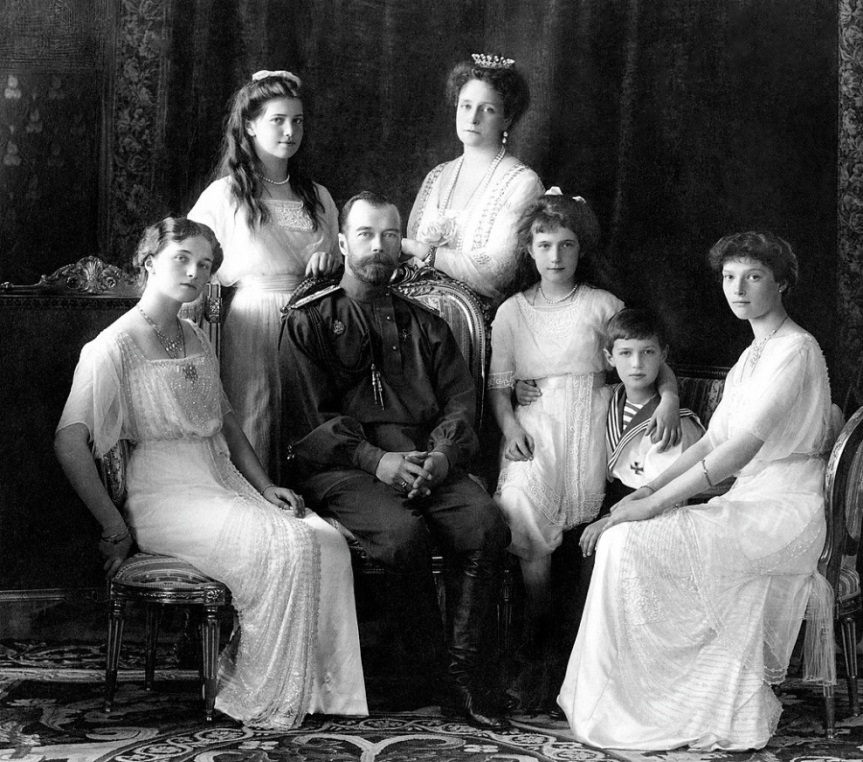
The ripples set in motion by the overthrow and murder of the Romanov family reached far and wide, not just in terms of the next hundred plus years, but likely for generations to come as the insipid reverie & barbarism of “socialism” replaced the hubris and, in Russia’s case, failure of Royal sovereignty. One small country that would feel the fall of the Tsar was Greece, or to be more specific the merchant fleets of the Greek Islands. As Greek merchant shipping was used to transport goods during WWI it is unsurprising there were heavy Greek shipping losses during its 4 year period. Following the war the Greek merchant fleet was considerably reduced but an even greater impact, perhaps, was that of the fall of the Russian monarchy. Traditionally the Greek merchantmen had traded the Black Sea via the Aegean Sea and the Bospherous, the narrow entrance between the Mediterranean Sea and the Black Sea at Constantinople, now Istanbul, a Turkish territory from Byzantine days (following the fall of Constantinople to Sultan Mehmed II, of the Ottoman Empire, in May of 1453)

The Bolshevik revolution would bring about changes to the traditional relationships in the whole Black Sea region, the establishment of the Union of Soviet Socialist Republics (USSR) under Marxist/Leninist doctrine, latterly known as Communism, would oust the traditional carriers to and from the region, and impose restrictions that pushed the Greek steamer fleets making it difficult to trade profitably. It did not help that in May 1919 the Greeks, persuaded largely by the British, had landed a military force in Izmir in the Anatolian region of Turkey. This was an allied attempt to take advantage of the 1914-1918 World War defeat of Austro-Hungary and its Ottoman Turk allies, but also a reaction to the Turkish advances into allied areas. The Turkish military, despite being ordered by the Ottoman Government to stand down following the war, refused and, in an atmosphere of nationalism and resistance to the Allies, had advanced into Greece, French held territories and Armenia (Macfie A. L. “The Chanak Affair” P1 Para1 Online Resource: https://ojs.lib.uom.gr/index.php/BalkanStudies/article/viewFile/5126/5155 Accessed: 15/02/2022). The Turkish Army headed by Mustafa Kemal Pasha would be a rallying call as Turkish nationalists rose against their Government, carrying out massacres of Christians to purge the area, and establishing the boundaries of what is modern day Turkey. Turkish control of Constantinople (Istanbul) was re-established and the Greek push into Antalya not only halted, but, in what the Turks called “The Great Offensive” was routed completely, giving the Turks complete control of the Chanak region, the entry to the Sea of Marmaris and, therefore, by extension the Bosphorous. Not only did this lead to an enduring mutual loathing between Turkey & Greece, but also to the Greek merchant fleet removing itself almost completely from the region in favour of other cargoes and ports…..
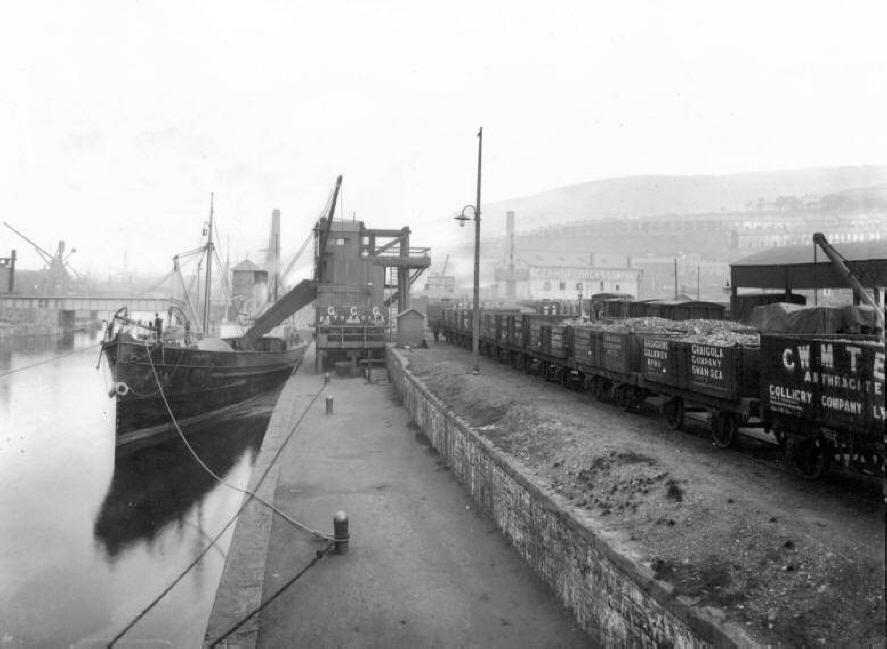
Greek vessels of the time were largely family owned, a family would pool together funds, go to the Greek government for a low interest loan and then buy second hand ships, often not in particularly great condition, man and run the vessels with family members throughout. As the Greek mainland is surrounded by Greek Islands, most of the merchant vessels were owned by traditional Island sea-farer families “Almost all of them come from the rocky Greek islands. The neighboring islands of Chios and Inoussai, for example, have produced such shipping families as Lemos, Kulukundis, Pateras, Carras, Papalios—who collectively own more than one-third of Greek shipping” (Editorial “Shipping: The other Greeks” P1. Para3. 15 August 1969. Online Resource: http://content.time.com/time/subscriber/article/ 0,33009,901268,00.html Accessed: 15/02/2022). Some Greek owners had bought before the end of the war, when shipping was scarce, hoping to capitalize on the high price commanded for running supplies between the allies and their critical supply-chains, once the war ended those high priced cargoes were scarce, merchant shipping was in decline and some of those expensive investments started to flounder in fairly suspicious circumstances, so much so that British Insurance Companies apparently “Black Listed” Greek merchant vessels from 1920 (Editorial “From a War to a Crisis (1919-1929)” Para 8. Online Resource https://greekshippingmiracle.org/en/history-2/1919/ Accessed: 15/02/2022)
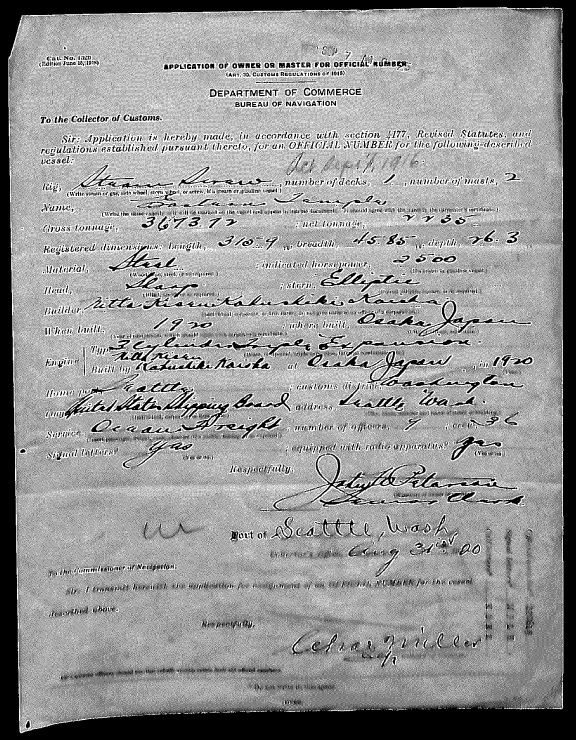
Now let us return to 1920 and the voyages of the United States Vessel the Eastern Temple! With the help of the US Coastguard and the US National Archive it is possible to dig out the various registration and transfers of Trade routes for Eastern Temple, and that begins with her original registration and the issuing of a Department of Commerce, Bureau of Navigation Number, 31st of August 1920. The official number was requested for her by Celias Miller of Seattle Washington, her declared purpose was “Ocean Freight”, Celias Miller was acting on behalf of the US Shipping Board, the original purchasers. Eastern Temple had only reached the USA from Osaka in late July of 1920, her first voyage from Tacoma 16th September of 1920 which would have meant some time for her new crew of 36 and her Master to get the feel of her before departure
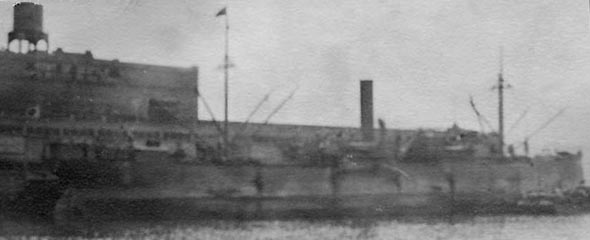
The Eastern temple was engaged in Ocean Trade under Master Albert E Winslow out of Seattle in September of 1920, then under Master Constantine Philip Zannaras out of New York in September of 1927, then under Master George D Skeriot out of Norfolk & Newport News in December of 1927, and, then under a Master T Nelson (likely Thorvald) out of Miami in July of 1929 and finally, as far as I can determine, under Master Thorvald Nelson out of Norfolk & Newport News in November of 1935, all the other masters were under registry licensing for coastal trading from the various ports noted. The means of determining this is by no means certain, it is assessed against the registry purpose stated on the license and the Captain and port noted on the license, I’d be delighted if any of the families or descendants of these Masters or crew can enlighten me with more detail from personal archives?

The Eastern Temple continued in both Ocean & Coastal roles between 1920 and 13th December of 1922 when an entry in the Consolidated Certificate of Enrollment & License, the yearly record of inspection and licensing for the USA has her “To be towed to the James River to Lay Up. No Inspection in Force” The US Shipping Board, presumably running out of cargoes or taskings by this time. It had largely been expected that a huge programme of re-building would take place and that there would be a continued need for shipping, this doesn’t seem to have materialized and the US Shipping Board has clearly got more ships than it requires
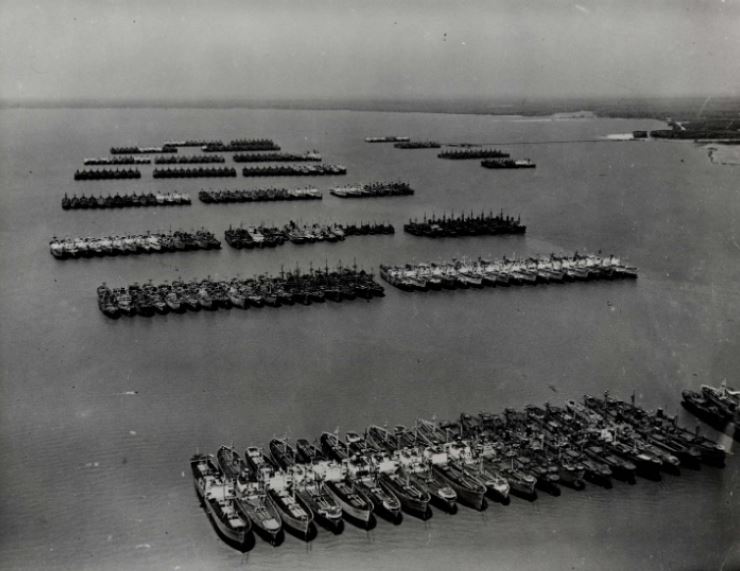
The laying up of the Eastern Temple would have been a new phenomenon after WWI, with a surplus of merchant shipping the US created the James River Reserve Fleet, wooden & steel ships moored up on the James River from Hampton Roads, at its height, the fleet consisted of somewhere around 800 ships. With such a huge fleet and the potential problems surrounding maintenance, access, up-keep etc the administration of the reserve fleet was given to the US Maritime Administration, a division of the US Department of Transport, not a military dependency, a civil authority who assigned it to the National Defense Reserve Fleet
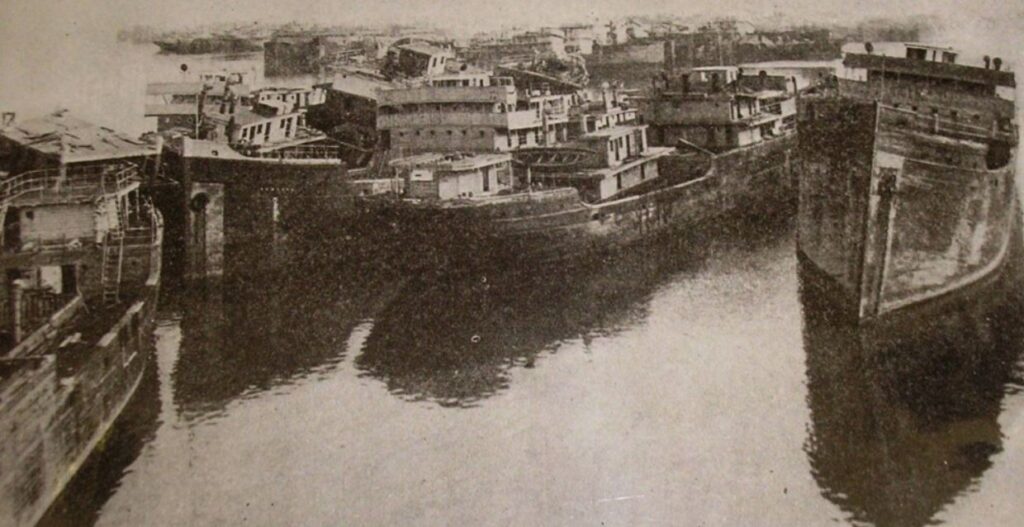
Colloquially known as the “James River Ghost Fleet”, not particularly surprisingly, the vessels were gradually reduced in number with some of the wooden boats ending up in the Potomac River. In 1920 around 169 of 218 vessels brought to the Potomac were beached in Mallows Bay (Shomette. D. “The Archeology of Watercraft Abandonment: The United States Shipping Board Fleet at Mallows Bay, Maryland: Inventory & Assessment” Abstract. Online Resource https://link.springer.com/chapter/10.1007/978-1-4614-7342-8_6 Accessed 15/02/2022) sadly most did not find further employment “….most were sold at auction in 1922 to the Western Marine and Salvage Corporation for reduction and salvage of the metals” despite several attempts at salvaging from the fleet, eventually they were lined up in rows and burned to the waterline, they rest where they sank, as a macabre but colourful nature reserve to this day
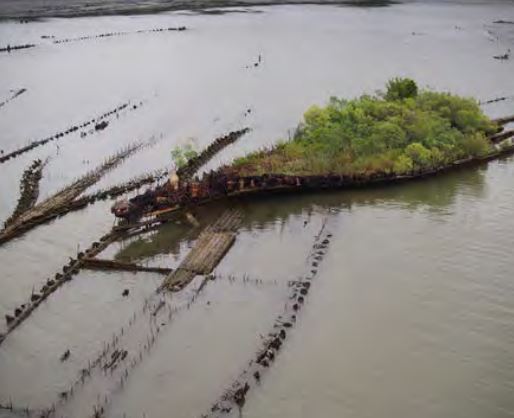
In what must have been a very close run thing, with so many vessels to choose from, the Eastern Temple would be fortunate enough to not share the fate of the Potomac Fleet, and would be brought out of the James River Fleet to go back into service after 5 years at anchor. The Eastern Temple is mentioned this time, 16th September of 1927, as a “Surrender of Ownership and Change of District” which sees her pass the into private ownership when a mortgage was arranged to the tune of $76000 at a rate of 5% interest on behalf of the High Seas Transportation Inc of 1819 Broadway, New York, a reasonably prestigious address by all accounts, at the Columbus Circle end of Central Park. Her new Master, Constantine Philip Zannaras, would have probably had his work cut out getting her crew to bring her back to inspection standards for her new owners the High Seas Transportation Inc of New York
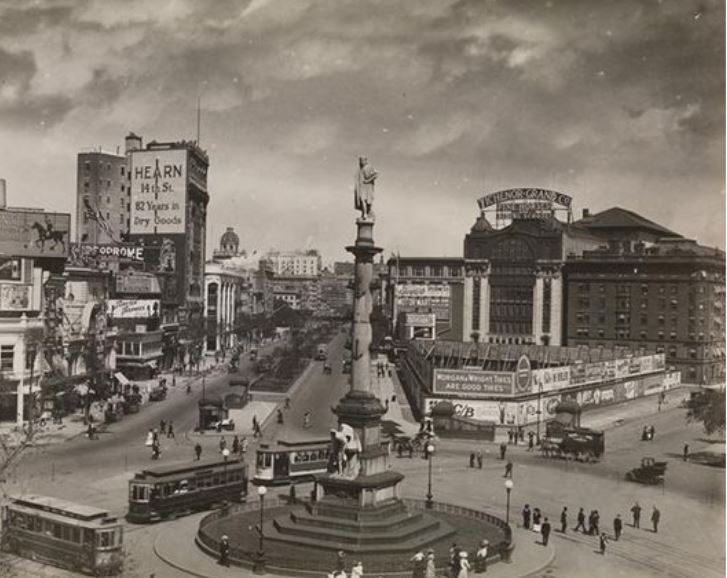
So Eastern Temple returns to the US Merchant fleet, purchased for the princely sum of $95000 with a balance due by mortgage (Judge Northcote: “The Eastern Temple in The Eastern Temple Zannaras v. United States.” Case 4223 13/01/1938 Online Resource: https:// www.leagle.com/decision/ 193846894f2d3741363 Accessed: 17/02/2022) “The amount secured by the mortgage had been reduced and amounted, in March, 1936, to $34,742.72. The vessel was purchased by High Seas Transportation, Inc.” It would seem that Constantine Philip Zannaras held a position as president of the purchasing company (High Seas Transportation Inc) and had also been employed as chief engineer on the Eastern Temple between September of 1927 and December of 1935 when the Eastern Temple was sold on by the US Marshall and the mortgage was to be cleared. Constantine Philip Zannaras claimed a debt against the sale value (closure of the mortgage) in respect of “wages owed” for the performance of duties other than those of chief engineer, it does not say anywhere I can find that Mr Zannaras was successful in his claim………. If nothing else, the claim of Mr Zannaras, and the various changes of Master and Ports of Registry during these years indicate that the Eastern Temple was at work, occasionally Ocean trading, more often Coastal Trading
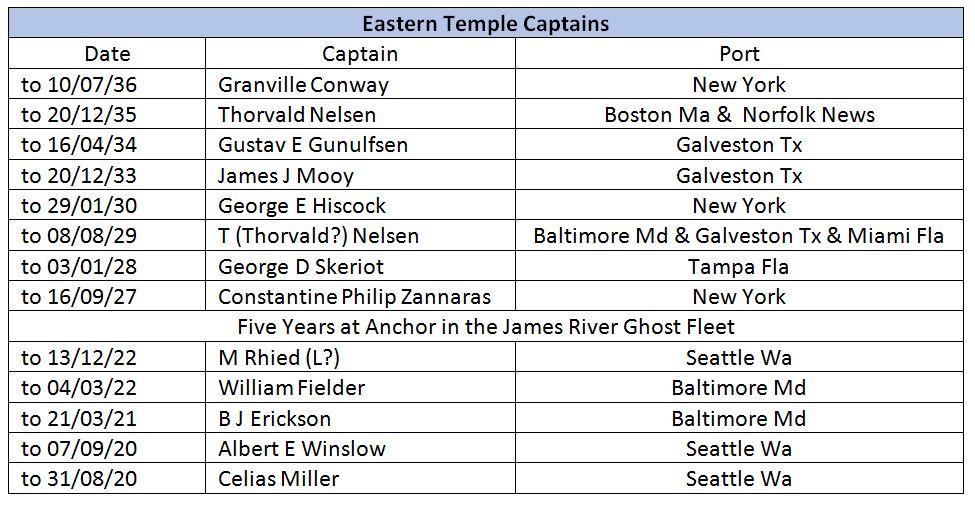
The use of “to” dates is not exact, however they are dates we can definitively say those captains had charge, even if some were named “in Lieu” of the former captain as noted when documentation (Port Registry etc) took place in the various ports identified. What this demonstrates is the varied Ports Eastern Temple was operating from and to during her US career. There is no account I can find of cargoes except for the arrival where she brought with her (according to the Morning Oregonian of 23rd July 1920) to the US “a full cargo of oriental merchandise”. As already noted, the Eastern Temple departed Tacoma with a full cargo of lumber when she left for her first voyage from the US 16th September of 1920. We can of course speculate at other cargo’s because of the nature of the major exports of a country from particular ports, it is likely The Eastern Temple carried Nitrates from Chile as that was the sole export at the time: “For years the Republic has enjoyed a monopoly of nitrates and supplied the entire world with this product. Chilean prosperity depended almost entirely upon this single industry….” (Green. S. & Lane. R. M. “Trade of the Pacific Coast States with the West Coast of South America: The present economic Condition of Chile” US Dept. of Commerce, Jan 1928, P12 Para1 Online Resource: https://books.google.co.uk/ books? id=F19zJ8JTZFoC&pg=PA1&lpg=PA1&dq= Trade+of+the+Pacific +Coast+States+with+the+West+Coast+of+South+America&source=bl&ots=sAhgsSm0xR&sig=ACfU3U2py0JLwGWRmyJk9wMT7Mywzil2uw&hl=en&sa=X&ved=2ahUKEwjj__KXl4n2AhVSXMAKHUHKBGgQ6AF6BAgrEAM#v=onepage&q=Trade%20of%20the%20Pacific%20Coast%20States%20with%20the%20West%20Coast%20of%20South%20America&f=false Accessed: 18/02/2022)
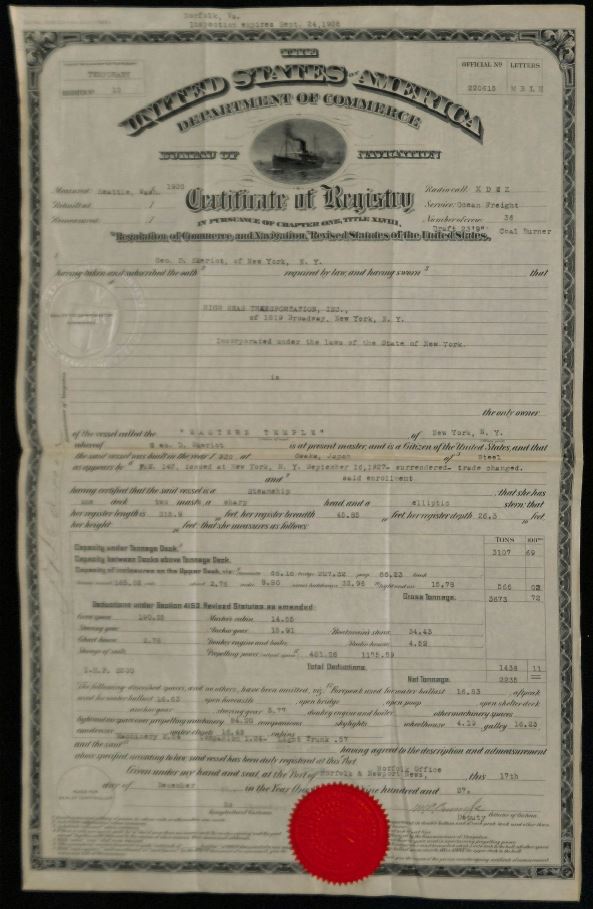
It is at this point we circle back to the Greeks, by 1925 Greece has moved a high percentage of its sea trade to the routes outside of the Sea of Marmaris, leaving the ports of the Black Sea to the Turks and the colonial companies still trying to establish relationships with the USSR and its communist leadership. Despite the move, perhaps because of it, the Greek shipping business was in crisis, the situation wasn’t helped by Britain recognizing the impact of Greek shipping in the 20’s entering their traditional markets for grain, and produce in Argentina and other South American ports, and raising insurance premiums on the Greek fleet. By 1925 with insurance of cargo’s going up and a market in decline: “The commercial secretary of the British Embassy in Buenos Aires reported that ‘the depressed condition of the market resulted in many steamers laying up in the river, and at one time some thirty Greek vessels alone were tied up at Villa Constitucion for several months’. After a short upheaval in 1926, freights fell again in 1927” (Harlaftis. G. “A History of Greek Owned Shipping: The making of an international tramp fleet 1830 to the present day” Routledge 1996. Online Resource: https:// www.academia.edu /5607030/3. _Gelina_Harlaftis_%CE%91_%CE%97istory_of_Greek-Owned_Shipping._The_Making_of_an_International_Tramp_Fleet _ 1830 _to_the_present_day _London _Routledge_1996 Accessed: 18/02/2022). By 1929 major ship-owners submitted a memorandum to the Greek Prime Minister laying out reasons the majority had moved their business to London as a trading base, and suggesting a re-flagging of all Greek shipping was imminent (Editorial “Greek Shipping Miracle: From a War to a Crisis (1919-1929)” Online Resource: https://greekshippingmiracle.org/en/history-2/1919/ Accessed 18/02/2022)
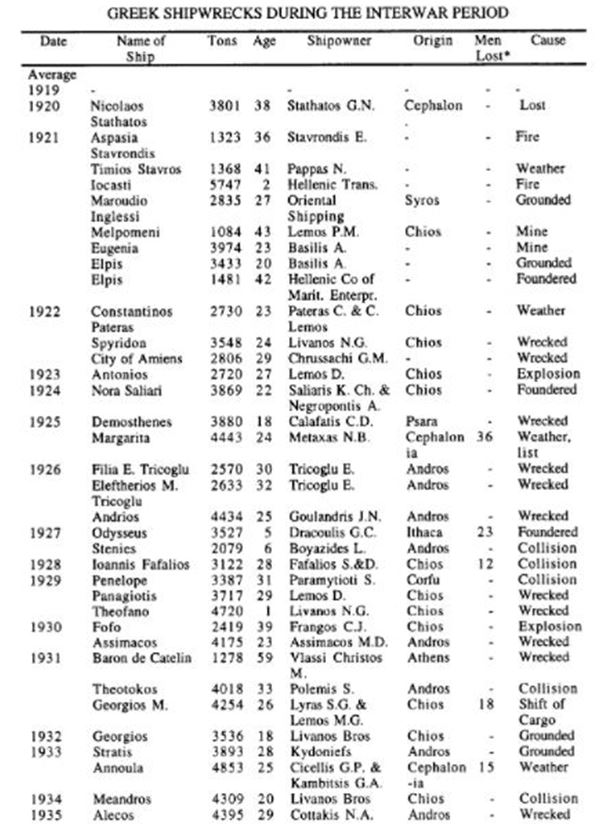
The First World War years saw the Greek fleets hit by torpedo, mine, lost in action etc…. following the losses of World War I, the World’s Port’s rapid growth was reversed, the USA was not the only country with too many ships and not enough cargo to keep their fleets viable. International trade declined as ravaged countries spent meager funds on reconstruction, then, in the 1930s, came the great depression in the USA and international trade plummeted as a result. It is surprising to see at least one Greek ship owner seemed to be unconcerned, a Senor E.M. Tricoglu of Eleftherios, Ándros Island, a visionary perhaps? The alarming rate of Greek Shipping losses of the First World War did not slow in the interwar years and was cause enough to see studies and even books & articles written (“Α history of Greek-Owned Shipping. The Making of an International Tramp Fleet, 1830 to the present day”: Harlaftis, G. Publisher: Routledge, 1996. And “At THE MERCY OF THE WAVES MANAGING RISK AT SEA IN THE GREEK FLEET OF THE INTERWAR PERIOD”: Harlaftis, G. In “The Great Circle” Journal of the Australian Association for Maritime History, Vol. 19, No. 2, 1997: 73-92) in later years trying to explain the unusually high loss rate
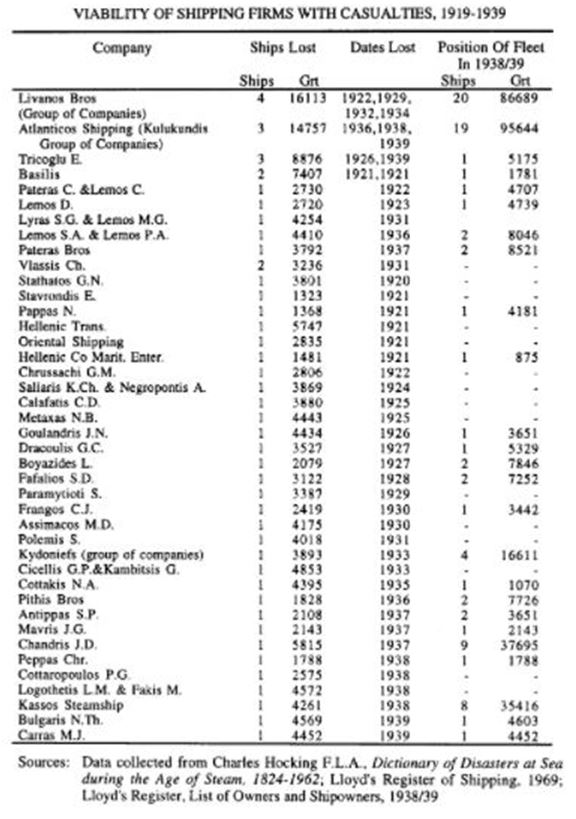
The Eastern Temple had operated under the ownership of the United States Shipping Board – USSB, Washington D.C. from 1920 to 1927, being sold on to another American concern, the High Seas Transportation Inc. of New York in 1927 and sailing under their flag until being sold on again by the US Marshall on behalf of the US Secretary of Commerce in 1935 to a Senor E.M. Tricoglu of Andros Island……. Now there had been several ships in the ownership of Senor Tricoglu that came to ignominious ends for one reason or another, the Filia E. Tricoglu, a 274hp, single screw, 3 cylinder steamer of 2489 grt, launched at Bremen 02/12/1895 (formerly the SS RUDELSBURG: 1895-1907, then the BABYLON: 1907 – 1923), which wrecked, “run aground” 27/01/1926 on Siphanto Island on passage from Sulina for Sweden with grain (http://www.teesbuiltships.co.uk/). Then, again in 1926, there was the ELEFTHERIOS M TRICOGLU, another single screw, 3 cylinder Steamship of 269hp & 2659grt (Launched as the SS BEEFORTH: 06/02/1894 – 1908 then as the PRODUGOL: 1908 – 1920, then becoming the ERGINUS 1920 – 1925), wrecked 29th January ’26 on Aranmore Island, County Donegal, on a voyage from Braila to Sligo with a cargo of maize (http://www.tynebuiltships.co.uk/). Finally there was the MINA E. TRICOGLU (Launched as the SS HAWKSER in 1915, becoming the SHEAF MEAD: 1919 – 1930) engaged in ‘deep sea tramping’ along the Pacific coast of North and South America with forays to Australia and the Far East until 9.10.1933 when she became “stranded at Civitavecchia” en-route from the Tyne carrying coal, then being a write-off, scrapped at La Spezia in 1934 (http://www.wrecksite.eu)
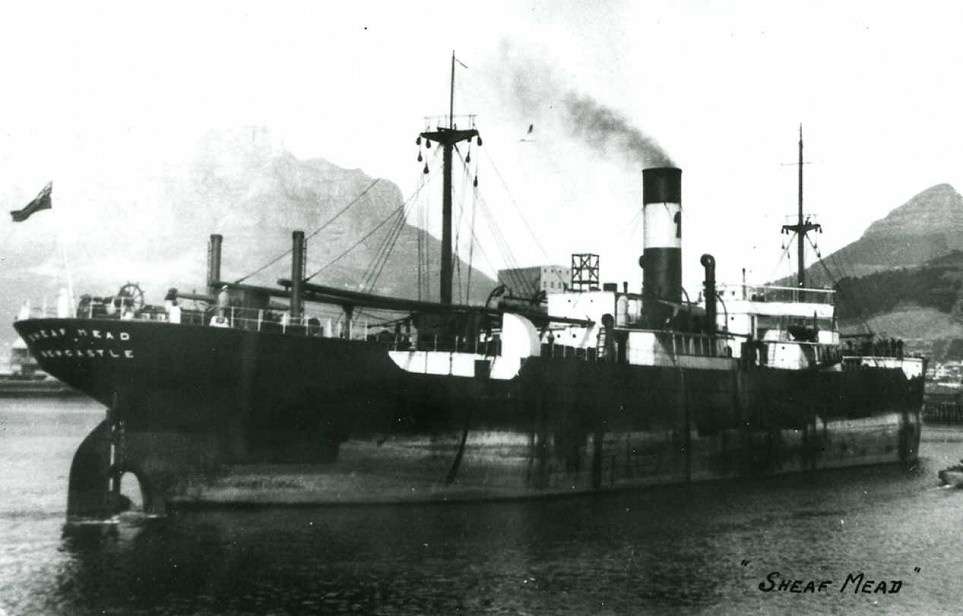
Now a loss rate such as that for one ship owner would raise eyebrows under almost any circumstances but war, and, following a global shipping crisis such as that seen between the wars, it cannot have gone unnoticed, however, it is not legally sensible to suggest anything more than a “healthy interest” in what my old boss would have called “previous” whenever such circumstances arose in the behaviors of those engaged in somewhat “concerning” activities…….
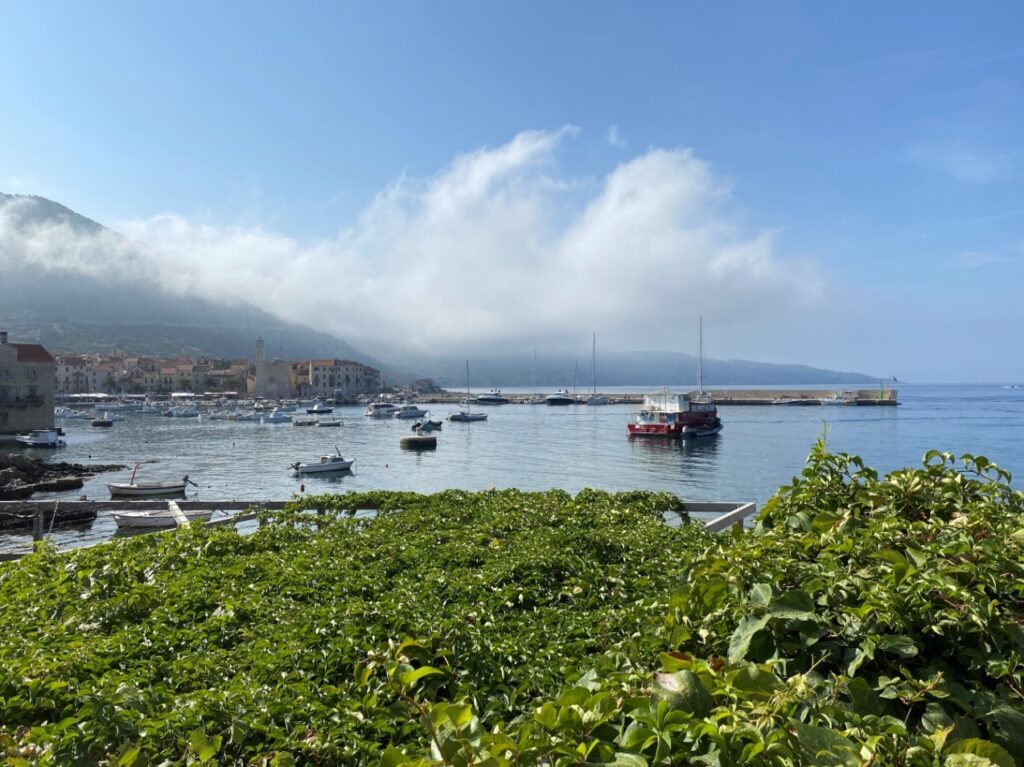
Suffice to say there are various theories as to the sinking of the Vassilios T, and a variety of possible causes noted:
(https://dive.site/explore/site/vassilios-t-wreck-q7vR:)
“Vassilios T. is a well-preserved wreck located off Vis Island, Croatia. In 1939, the 105-meter-long steamer loaded with coal was swept by strong winds on its way to Venice. Officially, it hit some rocks and sank off the western side of the island, but rumor has it that the crew sank the ship on purpose to receive compensation from the insurance company”
(https://divingvis.com/vassilios/:)
“In the stormy conditions the rudder of the ship – built in 1920, belonging to Greece and called Vassilios T. – got destroyed. This 104 m long steamer hit the rocks and finished the cruise on the western side of the island of Vis. There is a rumour that the crew specifically caused the accident so that the owner could have received compensation from the insurance company. Although in times of accident such delusions were commonplace, these are only anecdotal conjecture”
I will leave the reader of this piece to come to their own conclusion in regards to the loss of the Vassilios T, so recently the Eastern Temple, bought by a Senor Tricoglu in 1938, having run against the spit of land at Stupišće, within sight of Komiza harbour, indeed within around a 20 minute walk from the town itself, off the island of Vis, 19th March in 1939………
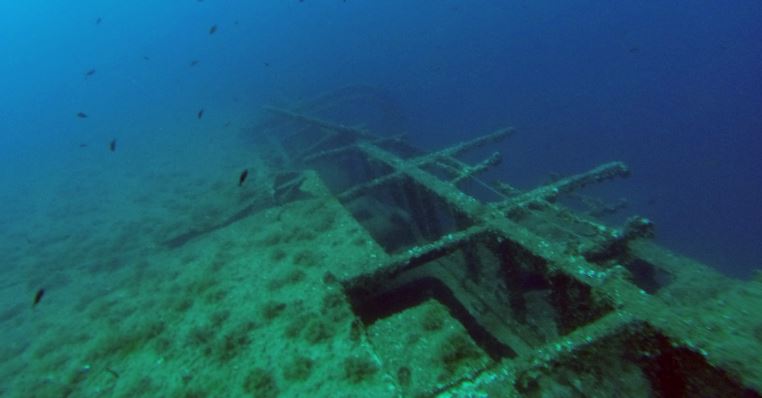
I first dived the Vassilios T in September of 2016 and have dived her regularly over the last 6 years, she is an outstanding dive lying on her Port side some 50m or so off Stupišće, a promontory just two miles or so out of Komiza, you could shore dive her from the steps leading to the shipping light placed on the spit to prevent other “accidents” to large, old coal carriers absentmindedly passing such a well charted and, even in 1939, well populated island…….Back in my old Navy Log I recorded: “07/09/16 WRECK OF THE VASSILIOS T off Komiza on Vis Island Croatia. This wreck hit the main part of the island in fog with damaged steering & now lies from 30 -55m on its side close in to shore I had serious tooth pain @ 32m descending along the port side towards the stern & had to stay above that to avoid pain. Swam back along the Port rail over 70 or so m of the 100m long wreck and it is a fantastic ship with so much to penetrate as it was an open hold steamer two front two rear this is one to do again. Viz 25m Air In 230 Out 150”

I only got the one dive on that holiday as my tooth really had a problem, it took root canal extraction to sort out and it would not be for another 3 years that I could get back to dive her again, by that time I had moved on to the Blue Dive Log and it records: “15/07/2019 VASSILIOS T KOMIZA CROATIA Redemption following 2016 tooth issue! This is an awesome wreck on its Port side from around 30m down to 50m we dived over the bridge just for’ard & dived along to the stern & over the rudder & prop & back along the starboard rail & in and along the promenade. Passed the bridge and up to the bow then back to the bridge and over the side to decompress the only issue is thick oil inside & tourist beaches don’t mix so penetration is prohibited Great Dive!”
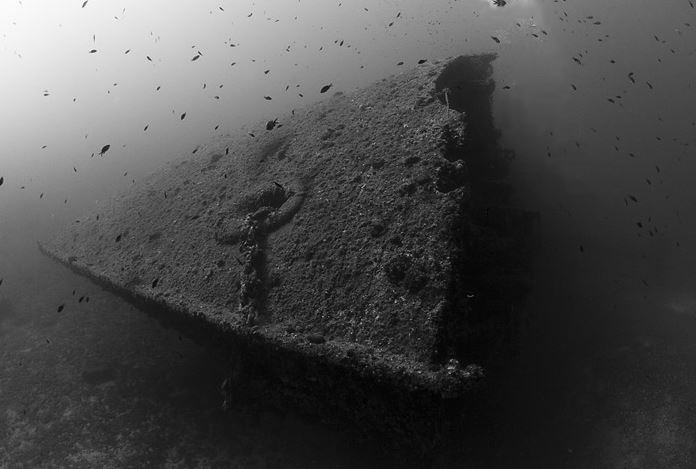
I managed to get back to Vis in August of 2021 following the Covid 19 outbreak over Christmas of 2019, when I got seriously ill and had a bad couple of months recovering some semblance of respiratory function, one of the few times I wondered if I was going to pull through an illness to be honest. I eventually felt well enough to dive again and arranged a week of diving with Andi & Aniska, the Blue Log recalls: “28/08/21 VASSILIOS T KOMIZA back to this wonderful 1939 wreck another navigational error! On her way from Swansea with a hold or 3 of coal she is sunk on her port side – Dropped in to the buoy on the anchor & swam the bow all down her length with stops at her bridge & mast & funnel, on to her stern mast & up over her railings to the rudder & prop. Carrying a side-mount for deco not room enough to pass between them went back over the side to swim the stern to forecastle & take a trip through the walkway up to the bow then on to deco a wonderful dive”. I dived her again three days later when a turn in the weather prevented us going to the Brioni which lies another hour round the headland, the Blue Book says “31/08/21 VASSILIOS T KOMIZA Back to Vassilios T for another dive as we cannot get round to Brioni. This time decided to stay around the bridge & forward end & got permission to enter the bridge area. Swam down to midships and over the starboard side& onto & into the bridge deck. Descended to the sea bed & swam round & through on various paths, great picking ways through easy to see & navigate as she is bare of wooden decking. Swam to the bows lighting up the forward hold on the way!”
Why not join me on that dive?
As I had not got much diving done in the August of ’21 I persuaded Ellie to go back in October for a second crack at the B17 and Brioni, as usual I started to work down to the depth taking another dive on the Vassilios: “11/10/21 KOMIZA CROATIA VASSILIOS T Trimix dive 19/19 to use up some of Andi’s spares from last week. Down to the bow then along her from stem to stern, plenty of wonderful fish shoals and Yellow/Purple coral growth on her superstructure & masts. A brief stop @ her bridge then down to her rudder & prop. Up & over her stern to the emergency steering locker & on to her holds & down her length. Another stop to swim through the promenade starboard deck & into the bridge over her spare anchor. Through the bridge & on to her bow & deco”
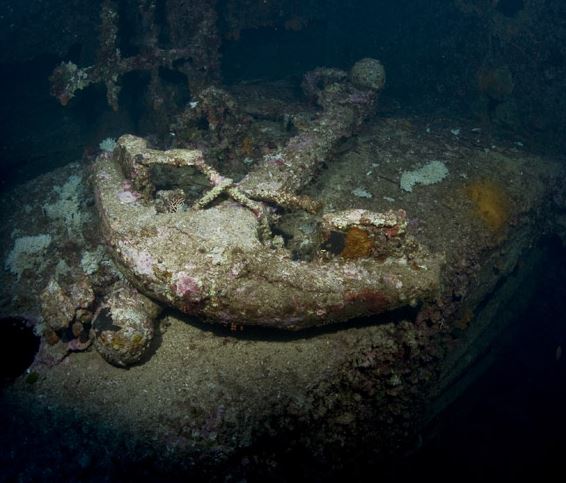
And so to this year’s escapade and my last dive to date on the superb wreck that is the Vassilios T and was, so recently before her demise, the Eastern Temple…. I failed to mention earlier that following the October dive on her of 2021 I once again succumbed to Covid 19, this time I was in Komiza and taken seriously ill with what I thought was Diverticulitis, something I have occasionally suffered from over the last ten years or so, I couldn’t stop violent stomach cramps for 4 days and sacked any idea of trying to get into a dry-suit and put on a weight belt….it wasn’t until we got back to the UK I found out it had actually been Covid…..again! Anyhow, I digress, this year everything went perfectly and I started the diving on the pinnacles to break in gently and followed that with Vassilios……. “29/08/22 VASSILIOS T ( EASTERN TEMPLE) Another fine dive on the Vassilios dropping in to find the anchor & chain then following the bow & starboard side down to the stern, a drop down to the sea bed & then a view of the prop & back up gently past the emergency steering room deck & up to the bridge. A quick swim through the bridge passage then on to the bow & back up for 11 minutes of deco” On this dive I noticed the impact to the bow, and the minor crack in her that eventually led to her demise, such a gentle and almost superficial break which would indicate a very slow speed when she hit Stupišće, perhaps caution in the fog had driven the captain to “slow ahead”…..perhaps…….
You can take a look for yourself on the dive, where you will perhaps also notice the Vassilios rudder looking completely untouched and serviceable……..
I have to say, Vassilios T is an amazing wreck, if there had not been so much doubt about her sinking, and perhaps such restrictions on penetration, maybe she would have been an equal favourite to the Brioni……….

Once again I am indebted to those who have taken or, where I was able to contact them, allowed the use of their photos for this piece, specifically those of the iliveunderwater.com dive blog site, Lindsay Muha & Frankie Witzenburg of the US National Archives at College Park, Scuba Diving Croatia.Com and Andi & Aniska of Manta Divers in Komiza
2024 Update: I returned to Komiza this year to dive with Andi & Aniska again and 1st off was the Vassilios T, in post dive conversation with Andi it turned out the history of the wreck had been largely unknown until her Greek ownership, Andi did not know her as the Eastern Temple and when I mentioned that it sparked a light……There had been, for as long as Andi knew, a bell, seemingly from Vassilios but with the letters RN somewhere as Andi recalled…..It turns out the bell was sat in front of a beach restaurant on the island of Bisevo and is indeed that of the Eastern temple
